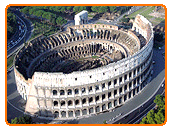 The Colosseum or Coliseum, originally the Flavian Amphiteatre is a giant amphiteatre in the centre of the city of Rome. Originally capable of seating around 50,000 spectators, it was used for gladiatorial contests and public spectacles. It was built on a site just east of the Roman Forum, with construction starting between 70 and 72 AD under the emperor Vespasian. The amphitheatre, the largest ever built in the Roman Empire, was completed in 80 AD under Titus, with further modifications being made during Domitian's reign. The Colosseum or Coliseum, originally the Flavian Amphiteatre is a giant amphiteatre in the centre of the city of Rome. Originally capable of seating around 50,000 spectators, it was used for gladiatorial contests and public spectacles. It was built on a site just east of the Roman Forum, with construction starting between 70 and 72 AD under the emperor Vespasian. The amphitheatre, the largest ever built in the Roman Empire, was completed in 80 AD under Titus, with further modifications being made during Domitian's reign.
The Colosseum was designed to hold 50,000 spectators, and it had approximately eighty entrances so crowds could arrive and leave easily and quickly.
The three tiers of arcades are faced by three-quarter columns and entablatures, Doric in the first story, Ionic in the second, and Corinthian in the third. Above them is an attic story with Corinthian pilasters and small square window openings in alternate bays. At the top brackets and sockets carry the masts from which the velarium, a canopy for shade, was suspended.
The plan is a vast ellipse, measuring externally 188 m x 156 m (615 ft x 510 ft), with the base of the building covering about 6 acres. Vaults span between eighty radial walls to support tiers of seating and for passageways and stairs.
The city needed an amphitheatre, as the only one with a (partially) stone structure had been built by Statilius Taurus in 29 BC and it was too small. The emperor Caligula (12-41 AD) had started the works for a new amphitheatre, but Claudius (10-54 AD) stopped them when he came to power. Nero, too, refused to use the old Statilius' facility and preferred to have his own amphitheatre built in the Campus Martis. It was a beautiful one, according to the historians, but it was destroyed, probably in the famous fire of AD 64.
The facade of three tiers osf arches and an attic story is about 48.5 m (158 ft) tall — roughly equivalent to a 12-15 story building.
It took about ten years to build the amphitheatre. Vespasian started the works in 72 AD and his son Titus (see him smiling in the statue on the right) dedicated it in the year 80 with magnificent games that lasted one hundred days. It is generally accepted that the building was completed by the following emperor, Domitian, Titus' brother.
The amphitheater is a vast ellipse with tiers of seating for 50,000 spectators around a central elliptical arena. Below the wooden arena floor, there was a complex set of rooms and passageways for wild beasts and other provisions for staging the spectacles. Eighty walls radiate from the arena and support vaults for passageways, stairways and the tiers of seats. At the outer edge circumferential arcades link each level and the stairways between levels.
|







